Oscillations in ciliary beat frequency and intracellular calcium concentration in rabbit tracheal epithelial cells induced by ATP
- PMID: 12563000
- PMCID: PMC2342584
- DOI: 10.1113/jphysiol.2002.028704
Oscillations in ciliary beat frequency and intracellular calcium concentration in rabbit tracheal epithelial cells induced by ATP
Abstract
To investigate how Ca(2+) regulates airway ciliary activity, changes in ciliary beat frequency (CBF) and intracellular calcium concentration ([Ca(2+)](i)) of rabbit tracheal ciliated cells, in response to ATP, were simultaneously quantified with high-speed phase-contrast and fast fluorescence imaging. [ATP]<or= 1 microM induced an increase in [Ca(2+)](i) and CBF that declined to the initial basal levels and was followed by irregular brief increases in [Ca(2+)](i) and CBF. [ATP] > 1 but < 16 microM induced a similar increase in [Ca(2+)](i) and CBF but this was followed by oscillations in CBF and [Ca(2+)](i). The minimum CBF of the oscillations in CBF remained elevated above the basal rate while the minimum concentration of the [Ca(2+)](i) oscillations returned to the basal level. The minimum and maximum CBF of the oscillations in CBF were independent of the [ATP], whereas the frequency of the oscillations in CBF was dependent on the [ATP]. Similar oscillations in CBF and [Ca(2+)](i) were induced by ATP- gamma -S. Although ADP, AMP and adenosine induced a Ca(2+)-independent increase in CBF, neither ATP nor ATP- gamma -S induced an increase in CBF when the Ca(2+) increases were abolished by 20 microM BAPTA AM, a result suggesting that ATP hydrolysis was minimal. [ATP] >or=16 microM induced a sustained elevation in CBF and only a temporary, non-oscillating increase in [Ca(2+)](i). A similar response was induced by thapsigargin (2 microM). Flash photolysis of caged Ca(2+) (NP-EGTA) produced both transient and prolonged increases in [Ca(2+)](i) which were accompanied by transient and sustained increases in CBF, respectively. From these results, we propose that CBF can be increased by a direct Ca(2+) -dependent mechanism that generates the rapid increases in CBF associated with the oscillations or by an indirect Ca(2+)-dependent mechanism that is responsible for the sustained minimum increase in CBF.
Figures




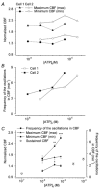
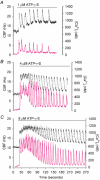
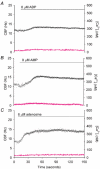
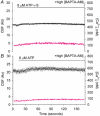
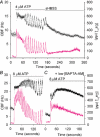

Similar articles
-
The role of cGMP in the regulation of rabbit airway ciliary beat frequency.J Physiol. 2003 Sep 15;551(Pt 3):765-76. doi: 10.1113/jphysiol.2003.041707. Epub 2003 Jun 20. J Physiol. 2003. PMID: 12819300 Free PMC article.
-
Prolonged increase in ciliary beat frequency after short-term purinergic stimulation in human airway epithelial cells.J Physiol. 2002 Jan 15;538(Pt 2):633-46. doi: 10.1113/jphysiol.2001.013222. J Physiol. 2002. PMID: 11790825 Free PMC article.
-
Intracellular calcium oscillations regulate ciliary beat frequency of airway epithelial cells.Cell Calcium. 1999 Sep-Oct;26(3-4):103-10. doi: 10.1054/ceca.1999.0060. Cell Calcium. 1999. PMID: 10598274
-
Respiratory Cilia as a Therapeutic Target of Phosphodiesterase Inhibitors.Front Pharmacol. 2020 May 6;11:609. doi: 10.3389/fphar.2020.00609. eCollection 2020. Front Pharmacol. 2020. PMID: 32435198 Free PMC article. Review.
-
Membrane control of ciliary movement in ciliates.Biol Cell. 1988;63(2):133-42. doi: 10.1016/0248-4900(88)90052-4. Biol Cell. 1988. PMID: 2849495 Review.
Cited by
-
Polyhexanide-containing solution reduces ciliary beat frequency of human nasal epithelial cells in vitro.Eur Arch Otorhinolaryngol. 2015 Feb;272(2):377-83. doi: 10.1007/s00405-014-3112-5. Epub 2014 Jun 6. Eur Arch Otorhinolaryngol. 2015. PMID: 24902802
-
A pilot study to examine the effect of chronic treatment with immunosuppressive drugs on mucociliary clearance in a vagotomized murine model.PLoS One. 2012;7(9):e45312. doi: 10.1371/journal.pone.0045312. Epub 2012 Sep 20. PLoS One. 2012. PMID: 23028925 Free PMC article.
-
Differential effects of cyclic and constant stress on ATP release and mucociliary transport by human airway epithelia.J Physiol. 2007 Apr 15;580(Pt. 2):577-92. doi: 10.1113/jphysiol.2006.126086. Epub 2007 Feb 22. J Physiol. 2007. PMID: 17317749 Free PMC article.
-
An Automated Measurement of Ciliary Beating Frequency using a Combined Optical Flow and Peak Detection.Healthc Inform Res. 2011 Jun;17(2):111-9. doi: 10.4258/hir.2011.17.2.111. Epub 2011 Jun 30. Healthc Inform Res. 2011. PMID: 21886872 Free PMC article.
-
Effects of histamine on ciliary beat frequency of ciliated cells from guinea pigs nasal mucosa.Eur Arch Otorhinolaryngol. 2015 Oct;272(10):2839-45. doi: 10.1007/s00405-014-3354-2. Epub 2014 Nov 4. Eur Arch Otorhinolaryngol. 2015. PMID: 25367704
References
-
- Berridge MJ. Inositol trisphosphate and calcium signalling. Nature. 1993;361:315–325. - PubMed
-
- Berridge MJ. The AM and FM of calcium signalling. Nature. 1997;386:759–760. - PubMed
-
- Boitano S, Dirksen ER, Sanderson MJ. Intercellular propagation of calcium waves mediated by inositol trisphosphate. Science. 1992;258:292–295. - PubMed
-
- Bootman MD, Collins TJ, Peppiatt CM, Prothero LS, Mackenzie L, De Smet P, Travers M, Tovey SC, Seo JT, Berridge MJ, Ciccolini F, Lipp P. Calcium signalling-an overview. Semin Cell Dev Biol. 2001b;12:3–10. - PubMed
Publication types
MeSH terms
Substances
Grants and funding
LinkOut - more resources
Full Text Sources
Miscellaneous

